Oracle企业门户内容管理解决方案
- 格式:pptx
- 大小:6.05 MB
- 文档页数:65
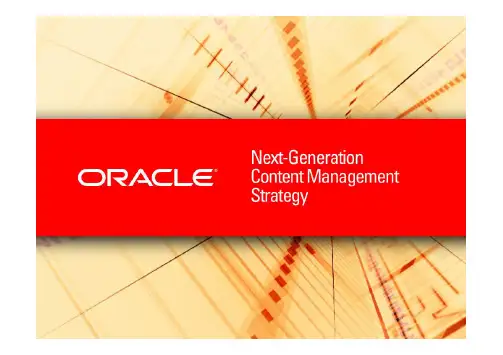
全面的企业内容管理平台——Oracle企业内容管理策略 何民雄 minxiong.he@ Oracle中国 内容管理 高级业务经理甲骨文技术峰会2007信息爆炸式增长文档、图像、声音、视频、即时消息、电子邮件 …企业内容管理的信息生命周期存储 捕获 版本 索引 创建 管理清理分发 发布 保持 检索企业内容管理的演变从:没有控制的环境 部门级的内容管理 复杂的用户界面 多个隔离的数据存储 私有的解决方案 很少的应用集成到:易于管理的系统 企业级的部署 标准的、熟悉的用户界面 所有的东西都存在数据库中 基于标准的基础架构 集成的业务流程未来应用和内容管理的发展趋势◆ 全局化 ◆ 工作区 ◆ 上下文相关 ◆ 嵌入式信息管理的领导者——OracleSource: Gartner May 2006, Worldwide RDBMS Total Software RevenueOracle内容管理技术发展•收购Stellent •Content DB 10g •Records DB 10g •Secure Enterprise Search 10gOracle 6~8Oracle 8iOracle 10g数据库 •收购TripleHop R1 Oracle9i 数据库 •收购ContextMedia R2 •ULDB/XML Query Oracle9i 数据库 •中文模糊查找 R1 •在线索引创建 •高速文本过滤SQL*TextRetrieval TextServer3 Oracle ConText Option Oracle ConText Cartridge•Oracle Text •中文分词 •iFS •interMedia Text •XML DB •Ultra Search •和数据库融合•并行索引创建 •Oracle Content Service •Oracle Records Management •Oracle Files1990年代前半1999/52001/102002/82004/42005/82006/22006/11Oracle内容数据库基础架构Oracle 电子商务套件ECM套装应用Desktop 应用层 Apps桌面应用Portals & 门户和 Web浏览器 BrowsersISV ISV 开发的应用 Apps工作流 (Oracle BPEL流程管理器)服务层身份安全 (Oracle身份管理)协作/门户 (Oracle Web Center) 搜索 (Oracle安全企业搜索)流程管理应 用 开 发 框 架内容库服务 (Oracle内容数据库)身份管理结构化数据 非结构化数据 元数据 (Oracle数据库) (Oracle内容数据库) (Oracle内容数据库) 全文索引 (Oracle文本)Web 服务管理 网格控制Oracle内容数据库10g全面的信息储存库内容管理:随时访问企业所有的内容客户端集成 收集/创建 保存/销毁其他的Oracle组件记录管理管理所有的电子文件管理/归档归类/组 织文档 据 元数HTTP其他的 Windows 应用 MS/ExplorerFTP文件库、流程、安全评审/批阅电子商务应用WebDAVMS/OfficeHTTPSFTPs安全/索引共享/ 检索文档流程WAP第三方应用/客户应 用迁入/迁出企业门户发布 Web内容移动用户内容协同Oracle Content DB 10gOracle Content Database 10g可以提供:◆ 开箱即用的基本内容管理和文档管理功能◆ 文档共享、生命周期管理、记录和存储管理 ◆ 企业级部署采用◆ 提供内容管理到所有的◆ 业务应用(于MIS的集成、萨班斯法案遵循) ◆ 业务流程(BPEL扩展)◆ ISV应用开发强大的内容基础架构◆ 行业相关的应用:所有需要处理非结构化数据的应用 ◆ 内容相关的应用:内容管理、知识管理、资源库通过数据库来管理您所有的内容Oracle Content DB 10g特性列表目录和文档级别的安全控制 基于组和角色的存取控制 多站点管理 基于Web Services的开发接口 迁入/迁出 基于策略的自动版本管理 事件驱动的工作流 工作流调用的 Web services 自动/强制 文档属性 符号链接 基于策略的记录和存储管理 病毒检测和扫描 增强的在线编辑Web界面 改进的桌面端客户程序,离线管理 和Mac更好的集成 和 E-Business applications 集成直观用户界面易于使用随时随地的用户访问◆ 从Windows资源管理器/Office/手机移动设备访问内容服务全文检索机制◆ 统一的搜索引擎 ◆ 简单和高级搜索 ◆ 关键词 ◆ 标题 ◆ 用户 ◆ 大小 ◆ 类别 ◆ 通过Oracle安全 企业搜索扩展信 息源Oracle Content Database 10g可以提供:◆ 开箱即用的基本内容管理和文档管理功能◆ 文档共享、生命周期管理、记录和存储管理 ◆ 企业级部署采用◆ 提供内容管理到所有的◆ 业务应用(应用的集成、萨班斯法案遵循) ◆ 业务流程(BPEL扩展)◆ ISV应用开发强大的内容基础架构◆ 行业相关的应用:所有需要处理非结构化数据的应用 ◆ 内容相关的应用:内容管理、知识管理、资源库通过数据库来管理您所有的内容Oracle Portal与内容管理Oracle BPEL 流程管理器下订单 检查库存 已脱销ß 警报替代的产品交付产品备用的产品规范 (内容)Oracle BPEL 流程管理器嵌入内容服务到业务应用的场景中Oracle安全企业搜索引擎架构Web 浏 览器Web Server 查 询和管理功能文本处理和索引Oracle Text SQL 引擎客户端搜索服务层 Crawler各种信息源全面的企业Intranet 搜索解决方案结构化数据电子邮件日程信息文件服务器人员 企业应用传统的 ECM协作解决方案Intranet Web 内容Internet Web 内容 商业智能Oracle电子商务应用与内容管理•可以共享、访问和更新处于应用之外的内容,包括集成其他的业务流程•在业务应用和信息资产之间建立更加强大的业务场景•利用增强的内容管理和记录管理功能来提升对信息的控制Oracle应用内容管理功能*Oracle保留产品计划变更的权力业务应用所需Oracle Content Database 10g可以提供:◆开箱即用的基本内容管理和文档管理功能◆文档共享、生命周期管理、记录和存储管理◆企业级部署采用◆提供内容管理到所有的◆业务应用(于MIS的集成、萨班斯法案遵循)◆业务流程(BPEL扩展)◆ISV应用开发强大的内容基础架构◆行业相关的应用:所有需要处理非结构化数据的应用◆内容相关的应用:内容管理、知识管理、资源库通过数据库来管理您所有的内容面向服务的内容管理架构面向服务的基础架构Web服务APIs:◆自动化◆集成◆功能扩展内容管理Web Services概览全面的内容管理解决方案应用场景:票据集中管理和应用收到票据(纸张拷贝)索引关键字段/批准或退回如果需要的话,票据路由道审核人员谢绝付款信Oracle ERP 应用应用场景:知识管理和资源库应用场景:文档审批提交应用场景:Web内容管理甲骨文技术峰会2007案例分析◆多个内容库并存◆多种技术◆高运营成本◆不一致的服务级别原来的环境现在的环境◆整合的单一非结构化内容库◆企业服务总线架构◆高可用的基础架构Claims Auditor ’s SystemsHuman ResourcesAnnuitiesOracle ContentDB单一权威,组织批准的针对企20062005200420032002• 2.8亿文档总数•大多数为tiff 格式的文档•10 TB 的内容存储•每天增加300,000 -500,000新文档•从Filenet 迁移过来2.7亿个文档,平均每天5百万文档•支持10,000 生产环境用户SAN Today Allstate: 应用架构和效果Allstate: 内容服务与业务应用◆56 个应用基于统一的Content DB◆关键业务应用◆Claims Management, Policy, Agency◆财务◆AP, GL◆HR◆Marketing◆Legal◆TravelAllstate ContentDB系统部署甲骨文技术峰会2007统一内容平台建设路线图如何规划建设统一内容信息平台时间业务价值Oracle 内容管理产品技术路线图统一通用的内容服务•融和中间件提供通用的内容基础架构•提供CDB 、Web 内容管理、数字资产管理、ILM 、I/PM 内容应用套件•整合领先的ECM 产品Stellent 到Oracle 内容管理产品线•充分利用Oracle 其他技术产品中的高级功能•可配置支持企业应用需求融和内容基础架构融和中间件信息权限管理(IRM )内容数据库套件Web 内容管理影像流程管理通用纪录管理(URM )AA数字资产管理信息生命周期管理AAA企业统一内容平台其他考虑因素◆内容的业务相关性和优先级◆统一内容平台和数据中心整合◆企业级演化和成本考虑◆现有业务应用的整合和未来应用规范◆导入内容管理到最终用户◆最佳实践案例和ROI◆……总结◆内容管理正在演进:从部门级到为企业所有用户提供内容管理,随时随地获取并服务于企业业务流程◆Oracle内容管理基于开放的数据库技术,采用SOA的架构和全面的内容管理服务于门户、业务应用、业务工作流◆Oracle内容管理提供了全面的内容管理套装应用,与电子商务应用、业务流程整合良好集成和扩展◆统一内容管理平台和可扩展的套装应用,整个组织需要一个统一内容数据管理和开发平台。
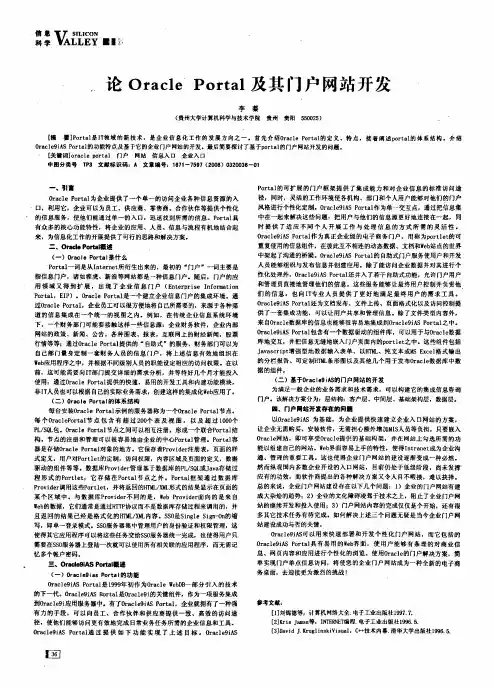
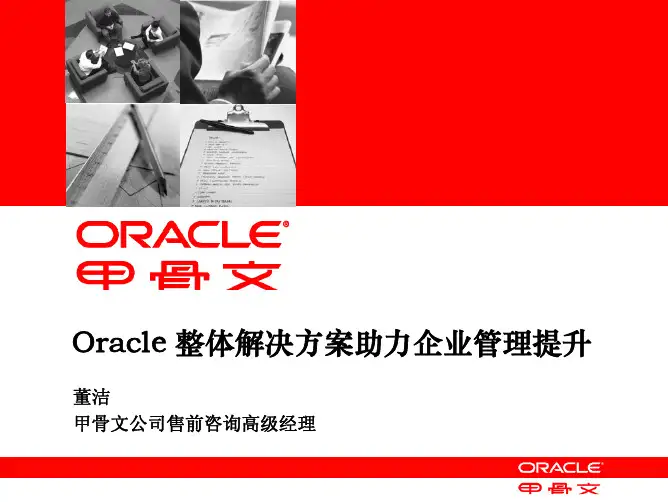
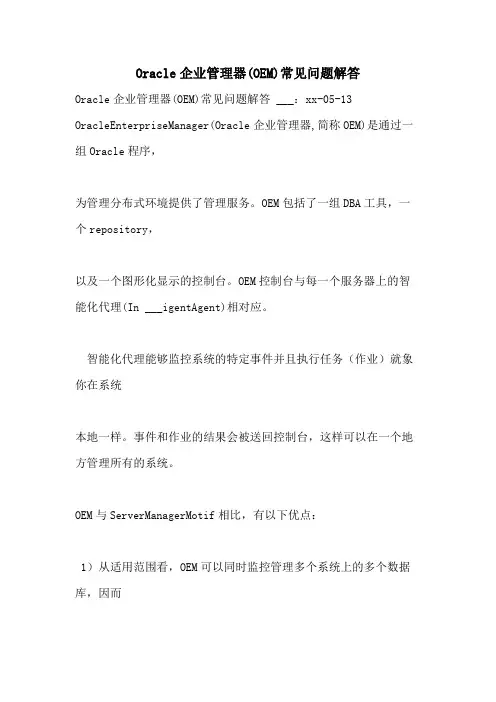
Oracle企业管理器(OEM)常见问题解答Oracle企业管理器(OEM)常见问题解答 ___:xx-05-13 OracleEnterpriseManager(Oracle企业管理器,简称OEM)是通过一组Oracle程序,为管理分布式环境提供了管理服务。
OEM包括了一组DBA工具,一个repository,以及一个图形化显示的控制台。
OEM控制台与每一个服务器上的智能化代理(In ___igentAgent)相对应。
智能化代理能够监控系统的特定事件并且执行任务(作业)就象你在系统本地一样。
事件和作业的结果会被送回控制台,这样可以在一个地方管理所有的系统。
OEM与ServerManagerMotif相比,有以下优点:1)从适用范围看,OEM可以同时监控管理多个系统上的多个数据库,因而特别适合分布式环境;而ServerManager只能监控管理一个数据库。
2)从管理对象看,OEM可以监控管理节点,数据库和监听进程(listener),而ServerManager只能监控数据库。
3)从适用版本看,OEM可以同时监控管理Oracle7.x和8.x,而从8版开始,ServerManager已不存在。
本文主要介绍一些OEM的常见问题及其解决方法。
Q:OEM数据库工具组的功能是什麽?A:OEM数据库工具组是一组使DBA能够通过GUI界面管理Oracle 数据库的工具。
包括以下工具:DataManager(数据管理器):这工具使你能够象加载数据一样执行数据的export/import。
SchemaManager:这工具使你能够在数据库中管理对象。
可以用于创建,修改,和删除tables,indexes,views,snapshots,sequences等等。
SecurityManager(安全性管理器):这工具使你能够管理用户,角色,权限及profiles。
StorageManager(存储管理器):这工具允许你创建和修改表空间,数据文件和回滚段.InstanceManager(实例管理器):这工具允许你关闭,启动实例并且存储和管理数据库参数。
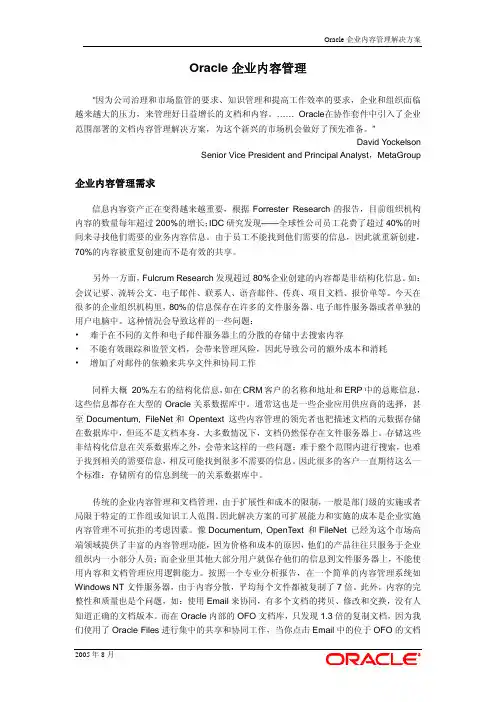
Oracle企业内容管理“因为公司治理和市场监管的要求、知识管理和提高工作效率的要求,企业和组织面临越来越大的压力,来管理好日益增长的文档和内容。
…… Oracle在协作套件中引入了企业范围部署的文档内容管理解决方案,为这个新兴的市场机会做好了预先准备。
”David YockelsonSenior Vice President and Principal Analyst,MetaGroup企业内容管理需求信息内容资产正在变得越来越重要,根据Forrester Research的报告,目前组织机构内容的数量每年超过200%的增长;IDC研究发现——全球性公司员工花费了超过40%的时间来寻找他们需要的业务内容信息。
由于员工不能找到他们需要的信息,因此就重新创建,70%的内容被重复创建而不是有效的共享。
另外一方面,Fulcrum Research发现超过80%企业创建的内容都是非结构化信息。
如:会议记要、流转公文、电子邮件、联系人、语音邮件、传真、项目文档、报价单等。
今天在很多的企业组织机构里,80%的信息保存在许多的文件服务器、电子邮件服务器或者单独的用户电脑中。
这种情况会导致这样的一些问题:•难于在不同的文件和电子邮件服务器上的分散的存储中去搜索内容•不能有效跟踪和监管文档,会带来管理风险,因此导致公司的额外成本和消耗•增加了对邮件的依赖来共享文件和协同工作同样大概 20%左右的结构化信息,如在CRM客户的名称和地址和ERP中的总账信息,这些信息都存在大型的Oracle关系数据库中。
通常这也是一些企业应用供应商的选择,甚至Documentum, FileNet和 Opentext 这些内容管理的领先者也把描述文档的元数据存储在数据库中,但还不是文档本身,大多数情况下,文档仍然保存在文件服务器上。
存储这些非结构化信息在关系数据库之外,会带来这样的一些问题:难于整个范围内进行搜索,也难于找到相关的需要信息,相反可能找到很多不需要的信息。
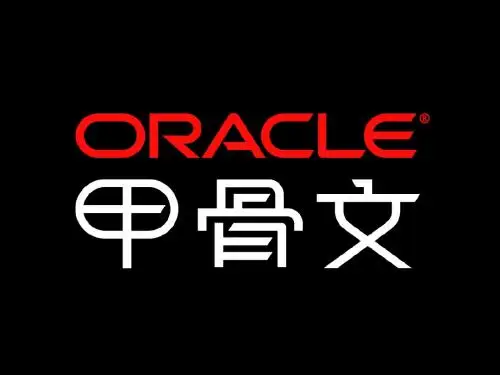
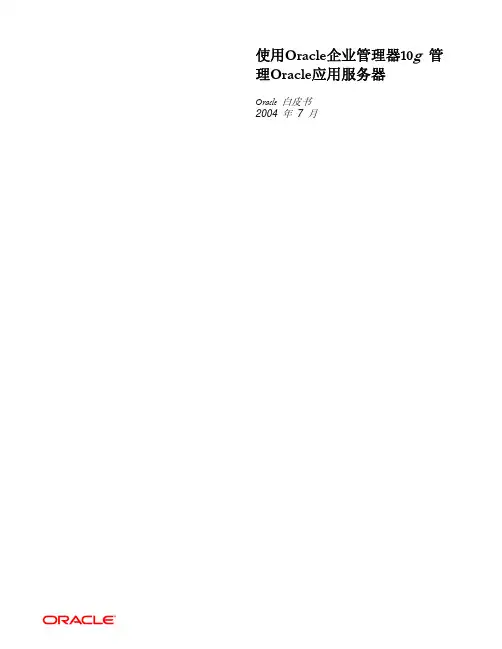
使用Oracle企业管理器10g管理Oracle应用服务器Oracle 白皮书2004 年 7 月使用Oracle企业管理器10g管理Oracle应用服务器引言 (4)管理拓扑结构 (4)随取随用管理 (5)集中和综合的管理 (5)使用应用服务器控制进行管理 (6)单点管理 (6)应用服务器环境的拓扑结构 (7)部署 J2EE 应用程序 (8)统一的管理操作 (9)集中的端口管理 (9)诊断日志查看器 (10)更改基础架构服务 (11)身份管理 (12)元数据信息库 (12)场信息库管理 (12)自动的服务保障 (13)使用网格控制管理 (13)随取随用的监视 (13)历史记录收集和分析 (14)J2EE 应用程序诊断 (15)应用程序服务级别管理 (15)应用程序可用性 (16)预先监视商务事务处理 (17)了解最终用户体验 (18)交互跟踪商务事务处理 (19)分析中间层页面的性能 (19)使应用程序性能相互关联 (20)管理应用服务器网格 (21)企业配置管理 (22)系统数据的自动收集 (22)报告收集的数据 (22)收集数据的查询和分析 (23)补丁 (24)克隆 Oracle 主目录 (25)结论 (26)使用Oracle企业管理器10g管理Oracle应用服务器引言Internet 为企业提供了快速发展更多客户的机会,同时降低了业务流程和信息系统的复杂性。
利用应用服务器(如 Oracle 应用服务器 10g)可以实现第二个好处,这些服务器允许用户集成完全不同的业务系统,并简化基于Web 的应用程序的开发和部署。
管理这样的动态应用服务器环境具有一定的挑战性。
Oracle 应用服务器提供了各种各样的功能,并在平台内集成了若干组件。
此外,应用服务器并不能独立存在,还需要其他服务和组件(例如,主机、数据库、负载平衡器等)作为应用服务器的宿主。
这样分散的环境自然很复杂,一直以来都需要经过培训的和专门的人员对其进行管理。
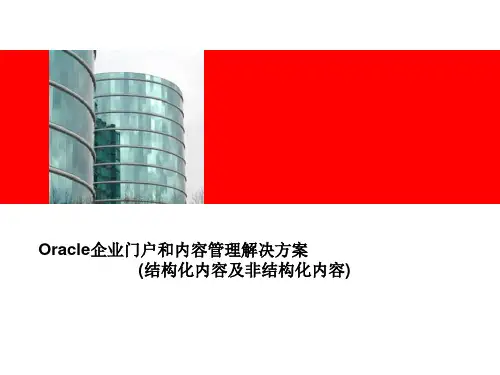
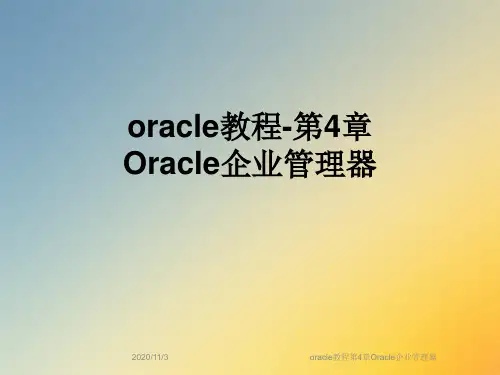
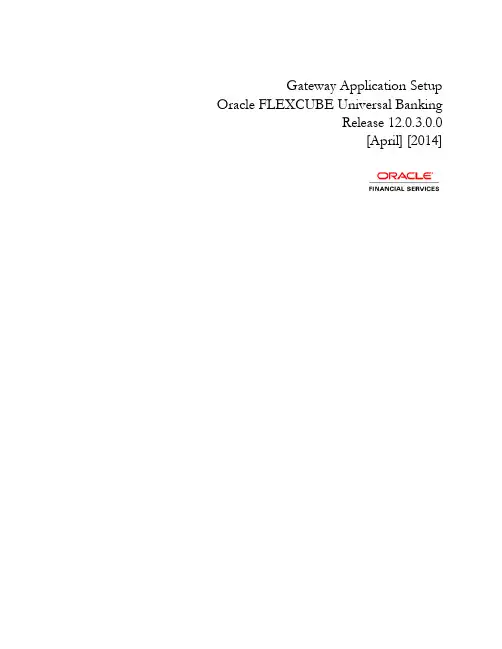
Gateway Application Setup Oracle FLEXCUBE Universal BankingRelease 12.0.3.0.0[April] [2014]Table of Contents1.SETTING UP GATEWAY FOR ORACLE FLEXCUBE ......................................................................................... 1-1 1.1I NTRODUCTION......................................................................................................................................................... 1-1 1.2S ETTING UP G ATEWAY EJB A PPLICATION................................................................................................................ 1-11.2.1Prerequisites .................................................................................................................................................... 1-11.2.2Building EAR File ............................................................................................................................................ 1-1 1.3S ETTING UP G ATEWAY MDB A PPLICATION ............................................................................................................. 1-91.3.1Prerequisites .................................................................................................................................................... 1-91.3.2Building EAR File ............................................................................................................................................ 1-9 1.4S ETTING UP G ATEWAY HTTP A PPLICATION .......................................................................................................... 1-171.4.1Prerequisites .................................................................................................................................................. 1-171.4.2Building EAR file ........................................................................................................................................... 1-17 1.5S ETTING UP G ATEWAY W EB S ERVICE A PPLICATION .............................................................................................. 1-241.5.1Prerequisites .................................................................................................................................................. 1-241.5.2Building EAR File .......................................................................................................................................... 1-242.POST BUILDING ACTIVITY ..................................................................................................................................... 2-1 2.1I NTRODUCTION......................................................................................................................................................... 2-12.1.1Gateway Configuration .................................................................................................................................... 2-12.1.2Deployment Using Oracle WebLogic Application Server ................................................................................ 2-12.1.3Deployment Using IBM Websphere Application Server .................................................................................. 2-11. Setting up Gateway for Oracle FLEXCUBE 1.1 IntroductionThis chapter explains the steps for setting up the Gateway Application for Oracle FLEXCUBE.1.2 Setting up Gateway EJB ApplicationThis section explains the methods of setting up Gateway EJB Application.1.2.1 PrerequisitesYou need to create the following gateway EJB property files before building the application: ∙gw_ejb_logger.properties∙GW_EJB_Prop.properties1.2.2 Building EAR FileIn order to build EAR file for Gateway EJB Application, you need to follow the steps given below:1. Launch Oracle FLEXCUBE Universal Installer. The welcome screen is displayed.2. Click ‘Next’.The following screen will be displayed.3. Select the application ‘Gateway’. Click ‘Next’.4. Specify the following details:File separator StyleSpecify the style of file separator (e.g Linux or Windows). Select the appropriate one from the drop-down list.Application ServerSpecify the application server in which you are creating the property file. Select the appropriate one from the drop-down list.ReleaseSpecify the release in which you are creating the property file.Select the appropriate one from the drop-down list. The options are:∙KERNEL∙VN Cluster5. Select ‘Build Application’. Click ‘Next’.6. Select ‘Gateway EJB’. Click ‘Next’.7. C lick ‘Next’ the following screen will be displayed.8. Specify the following details:Source DirectorySpecify the location of the source directory.Eg: Source_Dir\GatewayThe location of the source directory can be remote or local.Destination DirectorySpecify the location of the destination directory. The source files from the software gets copied to this location.Eg: D:\Testing\source\destApplication NameSpecify the EAR name of the application.The application name should not contain special characters and space. However, you may use ‘_’ (usnderscore).Eg: GWEJBMultiple SourcesIn case of Cluster/Patch releases, you can get the files from multiple source directories. If you check this box, the installer does not allow you to specify the source directory in this screen. On clicking ‘Next’, the following screen is displayed.You can select all the source directories in this screen. The Installer will copy the sources from the multiple locations into the destination directory. You can have consolidated sources in the destination directory.9. Once you have specified the details, click ‘Next’ to continue.The EJB reference name will be ‘{APPLICATIONAME}_GW_EJB_Bean’ and the JNDI name will be‘{APPLICATIONAME}/ejb/GW_EJB_Bean’.For example, consider that the application name is GWEJB. In that case EJB and JNDI names will be as follows:∙EJB reference name: GWEJB_GW_EJB_Bean∙JNDI name: GWEJB/ejb/GW_EJB_Bean10. Click ‘Next’. The following screen is di splayed.11. Specify the following details:Centralized Property FileTo modify an existing property file, you need to select the exact property file by clicking on the folder icon.Do not load the Logger.properties file. The installer will load that file automatically based on the property file.12. Click ‘Next’. The following screen is displayed.13. Specify the following details:Distributed SchemaSpecify whether this is a distributed schema or not. This is a read only component . the Distributed schema will be YES only if the property file has distributed schema.Data SourceSpecify the data source of the schema.14. Click ‘Next’. In case you have selected ‘Yes’ against Distributed Schema, the following screen isdisplayed.15. Specify the datasource names.16. Click ‘Next’. The following screen is displayed.17. Click ‘Copy’ button. The installer copies the files.18. Click ‘Next. The following screen is displayed.19. Click ‘Build’ button to start the build process. The installer builds the source files.This completes the EAR file generation process. The EAR file will be saved to the destination directory.1.3 Setting up Gateway MDB ApplicationThis section explains the methods of setting up Gateway EJB Application.1.3.1 PrerequisitesYou need to create the following gateway MDB property files before building the application: ∙gw_mdb_logger.properties∙GW_MDB_Prop.propertiesFor details, refer to the section ‘Gateway MDB Application’ in chapter ‘Setting up Property Files’ (04-PropertyFile_Setup).1.3.2 Building EAR FileIn order to build EAR file for Gateway MDB Application, you need to follow the steps given below:1. Launch Oracle FLEXCUBE Universal Installer. The welcome screen is displayed.2. Select the a pplication ‘Gateway’. Click ‘Next’.The following screen is displayed:3. Specify the following details:File Separator Style:Specify the type of file separator (e.g: Linux or Windows). Select the appropriate one from the drop-down list. You also need to specify the version of the selected operating system.Application ServerSpecify the application server in which you are creating the property file. Select the appropriate one from the drop-down list.ReleaseSpecify the release in which you are creating the property file.Select the appropriate one from the drop-down list. The options are:∙KERNEL∙VN Cluster4. Select ‘Build Application’. Click ‘Next’. The following screen is displayed:5. Select ‘Gateway MDB’. Click ‘Next’.The following screen is displayed:6. C lick ‘Next’ the following screen will be displayed.7. Specify the following details:Source DirectorySpecify the location of the source directory.Eg: Source_Dir\GatewayThe location of the source directory can be remote or local.Destination DirectorySpecify the location of the destination directory. The source files from the software will be copied to this location.Eg: D:\Testing\source\destApplication NameSpecify the EAR name of the application.The application name should not contain special characters and space. However, you may use ‘_’ (Underscore).Eg: GWMDBMultiple SourcesIn case of Cluster/Patch releases, you can get the files from multiple source directories. If you check this box, the installer will not allow you to specify the source directory in this screen. On clicking ‘Next’, the following screen is displayed.You can select all the source directories in this screen. The Installer will copy the sources from the multiple locations into the destination directory. You can have consolidated sources in the destination directory.8. Once you have specified the details, click ‘Next’ to continue.The EJB reference name will be ‘{APPLICATIONAME}_GW_MDB_Bean’ and the JNDI name will be‘{APPLICATIONAME}/ejb/GW_MDB_Bean’.For example, consider that the application name is GWMDB. In that case EJB and JNDI names will be as follows:∙EJB reference name: GWMDB_GW_MDB_Bean∙JNDI name: GWMDB/ejb/GW_MDB_Bean9. Click ‘Next’. The following screen is displayed.10. Specify the following details:Centralized Property FileTo modify an existing property file, you need to select the exact property file by clicking on the folder icon.Do not load the Logger.properties file. The installer will load that file automatically based on the property file.11. Click ‘Next’. The following screen is displayed.12. Specify the following details:Distributed SchemaSpecify whether this is a distributed schema or not. Select ‘Yes’ to indicate that this is a distributed schema. Otherwise, select ‘No’.Data SourceSpecify the data source of the schema.13. Click ‘Next’. In case you have selected ‘Yes’ against Distributed Schema, the following screen isdisplayed.14. Specify the datasource names.15. Click ‘Next’. The following screen is displayed.16. Click ‘Copy’ button. The installer copies the files.17. Click ‘N ext. The following screen is displayed.18. Click ‘Build’ button to start the build process. The installer builds the source files. This completes the EAR file generation process.The EAR file will be saved to the destination directory.1.4 Setting up Gateway HTTP ApplicationThis section explains the methods of setting up Gateway EJB Application. This is not applicable in EXEC mode of installation.1.4.1 PrerequisitesYou need to create the following gateway HTTP property files before building the application: ∙gw_http_logger.properties∙GW_HTTP_Prop.propertiesFor details, refer to the section ‘Gateway HTTP Application’ in chapter ‘Setting up Property Files’ (04-PropertyFile_Setup).1.4.2 Building EAR fileIn order to build EAR file for Gateway HTTP Application, you need to follow the steps given below:1. Launch Oracle FLEXCUBE Universal Installer. The welcome screen is displayed.2. Select the Application ‘Gateway’. Click ‘Next’.The following screen is displayed:3. Specify the following details:File Separator StyleSpecify the operating system in which you are creating the property file. Select the appropriate one from the drop-down list.Application ServerSpecify the application server in which you are creating the property file. Select the appropriate one from the drop-down list.ReleaseSpecify the release in which you are creating the property file.Select the appropriate one from the drop-down list. The options are:∙KERNEL∙VN Cluster.4. Select ‘Build Application’. Click ‘Next’. The following screen is di splayed:5. Select ‘Gateway Http Servlet’. Click ‘Next’.The following screen is displayed:6. C lick ‘Next’ the following screen will be displayed.7. Specify the following details:Source DirectorySpecify the location of the source directory.Eg: Source_Dir\GatewayThe location of the source directory can be remote or local.Destination DirectorySpecify the location of the destination directory. The source files from the software will be copied to this location.Eg: D:\Testing\source\destApplication NameSpecify the EAR name of the application.The application name should not contain special characters and space. However, you may use ‘_’ (underscore).Eg: GWHTTPApplication ContextBased on the Application type selected, the Installer displays the application context. However, you may modify the default value.Multiple SourcesIn case of Cluster/Patch releases, you can get the files from multiple source directories. If you check this box, the installer will not allow you to specify the source directo ry in this screen. On clicking ‘Next’, the following screen is displayed.You can select all the source directories in this screen. The Installer will copy the sources from the multiple locations into the destination directory. You can have consolidated sources in the destination directory.∙Once you have specified the details, click ‘Next’ to continue.∙The following screen is displayed.8. Specify the following details:Centralized Property FileTo modify an existing property file, you need to select the exact property file by clicking on the folder icon.Do not load the Logger.properties file. The installer will load that file automatically based on the property file.9. Click ‘Next’. The following screen is displayed.10. Click ‘Copy’ button. The installer copies the files.11. Click ‘Next. The following screen is displayed.12. Click ‘Build’ button to start the build process. The installer builds the source files. This completes the EAR file generation process.The EAR file will be saved to the destination directory.1.5 Setting up Gateway Web Service Application1.5.1 PrerequisitesYou need to create the following gateway HTTP property files before building the application: ∙gw_ws_logger.properties∙GW_WS_Prop.propertiesFor details, refer to the section ‘Gateway Web Services Application’ in chapter ‘Setting up Property Files’ 04-PropertyFile_Setup.You must create the environment variables for the corresponding application. For details, refer to thesection ‘For Gateway Web Service Application Building’ in chapter ‘Setting up Oracle FLEXCUBEInstaller’ (02-Installer_Installation).1.5.2 Building EAR FileIn order to build EAR file for Gateway Web Service Application, you need to follow the steps given below:1. Launch Oracle FLEXCUBE Universal Installer. The welcome screen is displayed.2. Select the Application ‘Gateway’. Click ‘Next’.The following screen is displayed:3. Specify the following details:Operating SystemSpecify the operating system in which you are creating the property file. Select the appropriate one from the drop-down list. YouApplication ServerSpecify the application server in which you are creating the property file. Select the appropriate one from the drop-down list.ReleaseSpecify the release in which you are creating the property file.Select the appropriate one from the drop-down list.The options are:∙KERNEL∙VN Cluster4. Select ‘Build Application’. Click ‘Next’. The following screen is displayed:5. Select ‘Gateway WebServices’. Click ‘Next’.6. The following screen is displayed:click ‘Next’ the following screen will be displayed.This screen is not displayed in EXEC mode of installation.7. Specify the following details:Source DirectorySpecify the location of the source directory.Eg: Source_Dir\GatewayThe location of the source directory can be remote or local.Destination DirectorySpecify the location of the destination directory. The source files from the software will be copied to this location.Eg: D:\Testing\source\destApplication NameSpecify the EAR name of the application.The application name should not contain special characters and space. However, you may use ‘_’ (usnderscore).Eg: GWWebServiesApplication ContextBased on the Application type selected, the Installer displays the application context. However, you may modify the default value.Multiple SourcesIn case of Cluster/Patch releases, you can get the files from multiple source directories. If you check this box, the installer will not allow you to specify the source directory i n this screen. On clicking ‘Next’, the following screen is displayed.In EXEC mode of installation, on clicking ‘Next’ after verifying the JAR requirement, you will be navigated to the following screen.Here you can specify details regarding source directory, destination directory and application name.XSD ModifiedYou can check this box if the installer needs to recompile web services with new XSDs. This is required when an XSD is modified.WSDL ModifiedYou can check this box if the installer needs to recompile web services with new WSDLs. This is required when WSDL is modified.In case of XSD or WSDL web services should be recompiled,Copy the modified service sources into the service source path (<services_source_path>). Remove the unmodified services and proceed.In case of FCUBS the services sourcepath is ‘Source_Dir\MAIN\<Module>\Gateway\Services’.8. Once you have specified the details, click ‘Next’ to continue.9. The following screen is displayed.10. Specify the following details:Centralized Property FileTo modify an existing property file, you need to select the exact property file by clicking on the folder icon.Do not load the Logger.properties file. The installer will load that file automatically based on the property file.11. Click ‘Next’. The following screen is displayed.12. Select the modules to be included for Web Services.13. Click ‘Next’. The following screen is displayed.14. Click ‘Copy’ button. The installer copies the files.15. Click ‘Next. The follow ing screen is displayed.16. Click ‘Build’ button to start the build process. The installer builds the source files. This completes the EAR file generation process.The EAR file will be saved to the destination directory.2. Post Building Activity 2.1 IntroductionThis section introduces you to the activities to be carried out after setting up the gateway applications. 2.1.1 Gateway ConfigurationGateway application looks for the required files inside the ‘XSD Path’ and ‘Logger File’ provided at thetime of Gateway Property creation.Refer to the step 7 in the chapter ‘Creating Property File for Gateway Applications’ in the manual ‘Setting up Property File’ for details.You need to maintain the following files in XSD Path and Logger Path:Path FilesLogger Path Logger path should contain the gateway property files generated by the Installer.For example, for Gateway EJB application, the installer generates the files‘gw_ejb_logger.properties’ and ‘GW_EJB_Prop.properties’. While creating the property file if you specify t he ‘Logger Path’ as ‘D:/Kernel11.1/GW_EJB/config/gw_ejb_logger.properties’, then you need to place both the files‘gw_ejb_logger.properties’ and ‘GW_EJB_Prop.properties’ inside the folder‘D:/Kernel11.1/GW_EJB/config/’.XSD Path XSD Path should contain the common XSD files as well as the gateway module specific XSD files which are related to gateway operation.Copy the common XSD files from ‘MAIN\Core\Gateway\COMMON’ to the XSD Path. Copy the module specific XSD files from ‘MAIN/<module>/ Gateway/XSD’ to the XSD Path.ServerState.xml should be copied in the XSD Directory fromGateway\Utilities\POSS\ServerState.xml2.1.2 Deployment Using Oracle WebLogic Application ServerFor details on the manual deployment using Oracle WebLogic Application Server, refer to the chapter ‘Gateway Application with WebLogic’ (GATEWAY_Applications_WL).2.1.3 Deployment Using IBM Websphere Application ServerFor details on the manual deployment using IBM Websphere Application Server, refer to the chapter ‘Gateway Application with Websphere’ (GATEWAY_Applications_WAS.doc).Gateway Application Setup[April] [2014]Version 12.0.3.0.0Oracle Financial Services Software LimitedOracle ParkOff Western Express HighwayGoregaon (East)Mumbai, Maharashtra 400 063IndiaWorldwide Inquiries:Phone: +91 22 6718 3000Fax:+91 22 6718 3001/financialservices/Copyright © [2007], [2014], Oracle and/or its affiliates. All rights reserved.Oracle and Java are registered trademarks of Oracle and/or its affiliates. Other names may be trademarks of their respective owners. U.S. GOVERNMENT END USERS: Oracle programs, including any operating system, integrated software, any programs installed on the hardware, and/or documentation, delivered to U.S. Government end users are "commercial computer software" pursuant to the applicable Federal Acquisition Regulation and agency-specific supplemental regulations. As such, use, duplication, disclosure, modification, and adaptation of the programs, including any operating system, integrated software, any programs installed on the hardware, and/or documentation, shall be subject to license terms and license restrictions applicable to the programs. No other rights are granted to the U.S. Government.This software or hardware is developed for general use in a variety of information management applications. It is not developed or intended for use in any inherently dangerous applications, including applications that may create a risk of personal injury. If you use this software or hardware in dangerous applications, then you shall be responsible to take all appropriate failsafe, backup, redundancy, and other measures to ensure its safe use. Oracle Corporation and its affiliates disclaim any liability for any damages caused by use of this software or hardware in dangerous applications.This software and related documentation are provided under a license agreement containing restrictions on use and disclosure and are protected by intellectual property laws. Except as expressly permitted in your license agreement or allowed by law, you may not use, copy, reproduce, translate, broadcast, modify, license, transmit, distribute, exhibit, perform, publish or display any part, in any form, or by any means. Reverse engineering, disassembly, or decompilation of this software, unless required by law for interoperability, is prohibited.The information contained herein is subject to change without notice and is not warranted to be error-free. If you find any errors, please report them to us in writing.This software or hardware and documentation may provide access to or information on content, products and services from third parties. Oracle Corporation and its affiliates are not responsible for and expressly disclaim all warranties of any kind with respect to third-party content, products, and services. Oracle Corporation and its affiliates will not be responsible for any loss, costs, or damages incurred due to your access to or use of third-party content, products, or services.。
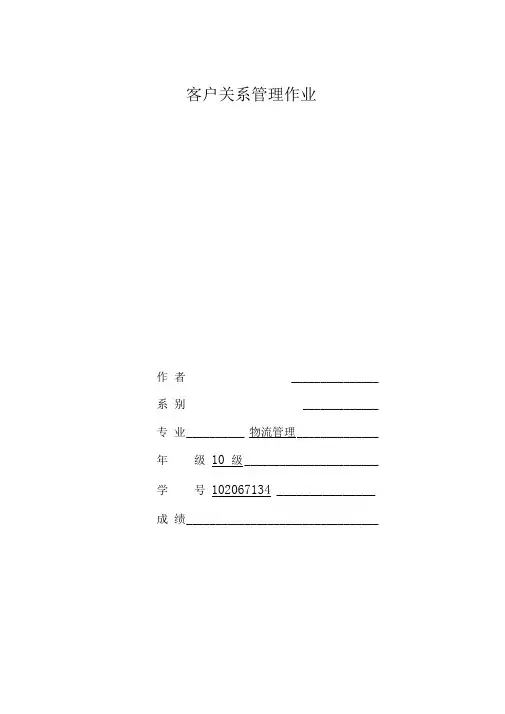
客户关系管理作业作者 _______________ 系别 _____________ 专业__________ 物流管理______________ 年级10 级_______________________ 学号102067134 _______________ 成绩_________________________________Oracle 公司针对金融行业的数据仓库解决方案一. 金融行业面临的问题和挑战今天,大多数银行都面临同样的问题,如何提高客户服务水平,如何控制金融风险,及如何提高银行的经营业绩,保证利润的持续增长。
银行在不断的采用新技术,扩充新的业务品种,力争突出经营特色,吸引更多的客户,但这些业务系统中大部分是独立建设的,互相之间的联系很少,数据和信息的传递、共享必须依靠复杂的应用程序才能完成。
如何建立有效的数据集成管理机制,如何充分利用银行积累的大量数据,为银行的科学化管理决策和发展新的业务服务,是目前银行急需解决的关键问题。
对于中国的银行业,同样迫切的是,中国加入WTO 的步伐正在加快,大量实力雄厚的外资银行在跃跃欲试,对我国金融业的生存和发展形成了严峻的挑战,也带来了机遇,由于金融和高技术领域的进一步开放,给金融电子化的发展提供了新的动力和契机。
由于解决2000 年问题而暂缓或停止的项目会在更高的起点上重新起步,导致开始新一轮金融电子化手段的竞赛。
从2001 年金融展看,数据集中、网上银行、无人银行、客户关系管理、数据仓库成为电子商务时代金融电子化发展的新趋势。
金融服务手段的不断创新,银行业竞争的加剧,其目标是一致的,既逐步改变银行传统的业务手段和经营模式,采用新技术,为客户提供更方便、更优质、更快捷的服务,并加速银行的管理决策过程,更快的适应市场,提高竞争优势,从而保证银行的可持续发展。
银行为了抓住机遇,适应挑战,必须解决下述两个关键问题:1.在优化业务处理的基础上,发展深层次的银行经营分析和决策支持系统:如何充分利用现有数据,统一银行内部所有的业务数据,为银行管理层提供一个真正涵盖全部业务的、全行范围的统一视图,帮助管理人员更好的理解并分析全行的业务运作情况,及时的发现问题、防范风险,对全行的业务均衡发展和经营战略管理提供辅助的决策支持工具。
蓝凌基于知识管理的企业门户(EKP)解决方案7蓝凌基于知识管理的企业门户(EKP)解决方案面对企业信息孤岛林立、数据管理复杂、业务流程处理混乱的现象,蓝凌基于对企业信息化、企业门户的深刻理解,总结多年的管理咨询经验、数百个企业软件实施服务经验,结合业界最新的SOA设计理念和最新IT技术,提炼出“基于知识管理的企业门户”软件解决方案,为企业提供统一的管理支撑平台,促进企业管理的精耕细作。
²蓝凌EKP解决方案内容EKP解决方案整体架构图示意如下:蓝凌EKP基于SOA设计理念,采用三层体系架构,由基础平台层、应用服务层、展现层构成,具体包括:²基础平台层:遵循跨平台、与平台无关的设计原则,在基础设施方面,支持主流的服务器、网络等硬件系统和Windows/Linux/UNIX操作系统,数据库支持DB2/Oracle/SQL Server等关系型数据库和IBM Lotus Domino文档数据库,应用中间件支持J2EE和.net Framework技术标准和主流产品;²应用服务层:提供业务功能的应用实现,包括公共服务层和应用功能层,公共服务层为应用功能层提供公共的基础服务,如知识管理基础服务、流程服务、消息服务、搜索服务、系统配置服务等,应用功能层在调用公共服务的基础上实现业务需求,满足不同的业务需要;²门户展现层:实现“以人为本”的个性化信息展现,根据企业、部门、个人的需求可灵活构建不同的门户,展现所关心的信息与知识,并提供多种接入方式。
根据企业应用需求的特点不同,蓝凌可提供更专业的软件解决方案,包括知识管理门户、协同办公门户、企业整合门户专业解决方案。
知识管理门户解决方案知识管理作为一个重要的管理思想和方法越来越受到企业的重视和关注,通过EKP解决方案可以构建企业知识管理平台,实现企业内部各种文档等显性知识、外部竞争情报、员工经验等隐性知识的统一管理,提供知识规划、沉淀、学习、应用、创新提供相应的支撑手段,并将人、流程和知识进行融合,让合适的员工在合适的场所及时获得所需的知识。